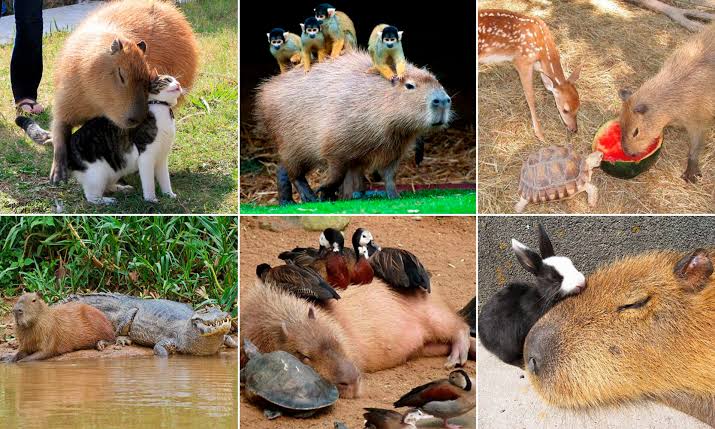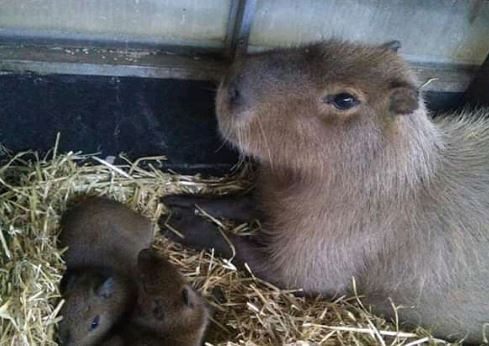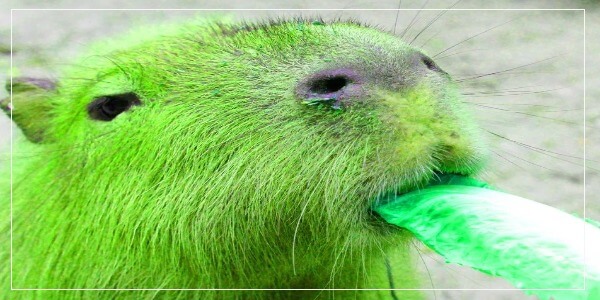Regarding capybaras, the largest rodents on our planet, their survival strategies are nothing short of remarkable. Capybaras are prey to several creatures, including anacondas, jaguars, and caimans, so it will be interesting to know how these rodents defend themselves and their young ones from these predators.
With their endearing appearances and social nature, Capybaras may not strike you as fierce warriors, but rest assured; they possess an array of techniques that help them navigate the challenging aspects of their habitat.
Whether it’s evading predators, communicating within their groups, or utilizing their physical attributes, these charismatic creatures have some fascinating tricks up their fur sleeves.
How Do Capybaras Defend Themselves?
Renowned as the largest rodent in the world, capybaras possess a fascinating array of adaptations and behaviors, including an intriguing defense mechanism that helps them navigate their sometimes challenging environments.
1. Group Living and Vigilance
Capybaras are highly social animals and typically live in groups consisting of several individuals. This group living strategy provides them with increased vigilance and protection against predators.
While resting or foraging, capybaras take turns keeping watch for potential threats, allowing the rest of the group to relax and graze without constant worry.
2. Communication
Effective communication is crucial for capybaras to warn the group about approaching danger. They use various vocalizations, including barks, whistles, and purrs, to convey different messages.
When capybaras detect predators, they emit loud alarm calls to alert other group members, prompting them to seek cover or flee to safety.
3. Hiding and Camouflage
Capybaras are excellent swimmers and spend significant time underwater. When threatened, they use their aquatic abilities by diving into rivers, lakes, or marshes.

By submerging themselves, capybaras make it difficult for predators to pursue them. Their brownish or grayish fur also helps them blend with the surrounding vegetation, providing effective camouflage against potential threats.
4. Strength in Numbers
Predators often target weak or vulnerable individuals within a group. Capybaras understand this and stick together to present a formidable force. The larger the group, the more challenging it becomes for predators to single out and attack a specific capybara.
This strength in numbers is a deterrent to potential predators, making it less likely for them to launch an attack.
5. Self-defense Mechanisms
While capybaras are generally peaceful animals, they possess physical defense mechanisms to protect themselves when necessary. They can use their sharp front incisors to deliver powerful bites if threatened.
Capybaras can also defend themselves by charging or lunging at predators with their robust bodies. While they prefer to avoid confrontation, these defensive behaviors can help ward off predators.
6. Utilizing Wetland Environments
Capybaras have a unique advantage in their wetland habitats. Thanks to their webbed feet, they are skilled swimmers, enabling them to navigate through water easily.
When pursued, capybaras will often escape into water bodies, where predators like jaguars or caimans have a harder time reaching them. This adaptation allows capybaras to seek refuge in their watery domain, evading potential threats.
RECOMMENDED FOR YOU:
Do Capybaras Use Their Size and Strength as a Defense Mechanism?
Yes, capybaras do use their size and strength as a defense mechanism. As the largest rodents in the world, capybaras have a considerable advantage regarding their physical size. Adult capybaras can weigh 50 to 100 pounds (23 to 45 kilograms) and have a robust, barrel-shaped body.
When faced with a potential threat, capybaras may rely on their size to intimidate predators or discourage aggression. They can appear more imposing on their hind legs, showcasing their impressive stature. By doing so, capybaras may deter smaller predators or dissuade potential attackers from pursuing them.
Furthermore, capybaras possess strong jaws with sharp incisors that they can use defensively. While they are generally peaceful animals, capybaras can bite in self-defense if they feel threatened or cornered.
How Do Capybaras Communicate With Each Other to Warn About Potential Dangers?
Capybaras, being social animals, have developed effective communication methods to warn each other about potential dangers. One way they communicate is through vocalizations.
Capybaras can produce a range of sounds, including whistles, barks, and purrs. When they sense danger, they emit loud alarm calls that alert nearby group members. These calls serve as a warning signal, indicating the presence of a threat.
In addition to vocalizations, capybaras use body language to communicate danger. They have a repertoire of postures and gestures that convey different messages. For instance, when a capybara senses danger, it may stand upright, raise its head, and sniff the air to assess the source of the threat.
They may also flatten their bodies or crouch low to the ground, signaling that danger is imminent and urging other members to take evasive action.
Scent marking is another form of communication among capybaras. They have scent glands located on their nose and rump, which they use to mark their territory. When capybaras detect a potential threat, they may intensify scent marking to communicate the presence of danger to their group members.
How Strong is Capybara Bite?
Capybaras have sharp incisors adapted for cutting through vegetation but can also deliver a formidable bite when threatened or provoked. Their front teeth are strong and continuously growing, allowing them to gnaw through tough plant material. While there is limited scientific data specifically quantifying the bite force of capybaras, it is estimated to be quite strong considering their size.
While capybara bites can be powerful, respecting their natural behavior and maintaining a safe distance when observing them in their natural habitat or captivity is important.
Interactions with capybaras should always be approached with caution and under the guidance of knowledgeable professionals to ensure the safety and well-being of both humans and these unique animals.
What Happens if a Capybara Bites You?

If a capybara bites you, it can cause some discomfort and potentially lead to injuries. Capybaras have sharp incisors that they use for various purposes, including defense. Their bites can be painful and may result in bruising, puncture wounds, or lacerations, depending on the severity of the bite. Capybaras have powerful jaws so that a bite can cause significant damage.
While capybaras are generally peaceful animals and not known for aggression towards humans, there are instances where they may bite if they feel threatened or cornered. It’s important to remember that capybaras are wild animals and should be treated with respect and caution.
If a capybara bites you, it is recommended to seek medical attention. The wound should be cleaned thoroughly to prevent infection; stitches may be required if necessary. It is also crucial to observe the wound for any signs of infection, such as redness, swelling, or discharge, and consult a healthcare professional if any complications arise.
Can Capybaras Swim to Escape Predators?
Yes, capybaras are excellent swimmers and can use swimming as a means to escape from predators. Their semi-aquatic lifestyle allows them to utilize their unique water survival adaptations. Capybaras have partially webbed feet, enabling them to navigate aquatic environments easily. They are highly skilled at swimming and can move swiftly in the water, making it difficult for predators to catch them.
When capybaras sense danger or perceive the presence of predators, they often seek refuge in bodies of water such as rivers, ponds, or marshes. They will swiftly enter the water and submerge themselves, with only their noses and eyes above the surface, remaining concealed from their pursuers. Their ability to hold their breath for several minutes helps them stay submerged and hidden.
Swimming allows capybaras to escape predators and gives them a significant advantage in their habitats, as many potential predators, such as jaguars and caimans, are not as proficient in water as capybaras.
By utilizing their swimming skills and seeking shelter in water, capybaras can effectively evade predators and increase their chances of survival.
Conclusion
Capybaras rely on their exceptional social behavior as a form of defense. Living in large groups called herds gives them strength in numbers and enhanced vigilance.
Their ability to communicate and alert each other about potential dangers is crucial in preventing predators. Additionally, their herd structure allows for collective defense, forming a protective circle around vulnerable individuals, such as young capybaras.
Another unique defense mechanism employed by capybaras is their exceptional swimming ability. They are excellent swimmers, equipped with webbed feet and a streamlined body to move swiftly through the water.
When faced with danger, capybaras can quickly dive into nearby bodies of water, utilizing their aquatic prowess to escape predators. They can stay submerged for several minutes, making it difficult for predators to pursue them.


![Why Do Capybaras Not Have Tails? - [Answered] Why Do Capybaras Not Have Tails](https://capybaratips.com/wp-content/uploads/2023/03/Capy-Tail-250x200.webp)




![How Long Do Capybaras Live? - [Answered] How Long Do Capybaras Live](https://capybaratips.com/wp-content/uploads/2023/03/Capybara-Pix-250x200.webp)

